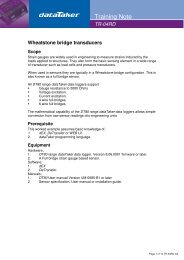You also want an ePaper? Increase the reach of your titles
YUMPU automatically turns print PDFs into web optimized ePapers that Google loves.
Verbose mode should normally be switched on when manually entering <strong>CANgate</strong> commands and slot definitions. Once you<br />
are confident that the slots are working as expected, Verbose mode can be turned off.<br />
When <strong>CANgate</strong> is being controlled by a DT80/800 data logger, Verbose mode is normally switched off. This avoids any<br />
parsing complications which may occur due to unexpected messages returned by <strong>CANgate</strong>.<br />
The current Verbose mode setting is saved to flash memory so it will be restored following a power interruption.<br />
VERSION – Display Firmware Version<br />
VERSION<br />
This command will return the version number of the <strong>CANgate</strong> firmware, eg. 1.24, followed by CRLF.<br />
In Verbose mode, the product name is also included.<br />
The VERSION command is a useful check that the host port communications are correctly configured and <strong>CANgate</strong> is<br />
responding, as it should always return some text in response to this command.<br />
RESET – Clear Memory Slots<br />
RESET<br />
This command will clear all defined memory slots. It does not affect the currently configured CAN/GPS bit rates, or the<br />
current verbose mode setting.<br />
SNOOP – Report CAN/GPS Activity<br />
SNOOP port { snoopTime }<br />
where<br />
port is either the CAN port number (1 or 2), or GPS.<br />
snoopTime is the time to spend listening (integer, in ms, must be multiple of 100ms). Default is 10000 (10 seconds).<br />
This command may be used to determine which CAN identifiers are being broadcast on a CAN network. During the specified<br />
snoop time, all incoming CAN messages on the specified port are received. For each distinct CAN identifier that was<br />
received, the following information is displayed:<br />
identifier type: standard 11 bit (STD) or extended 29 bit (EXT)<br />
identifier value, in hexadecimal<br />
the 64-bit data value from the first received message with this identifier<br />
If GPS is specified instead of a CAN port number, this command will display all NMEA strings that are received during the<br />
snoop period. This is useful for verifying that the GPS unit is sending the expected strings.<br />
Examples<br />
SNOOP 1<br />
EXT 18FEF000 FFFFFF0000F0CCFF<br />
EXT 18F0000F C07DFFFF0FFFFFFF<br />
EXT 18EBFF00 0115FF5E0004016F<br />
EXT 18ECFF0F 20130003FFE1FE00<br />
EXT 18EBFF0F 010306602254A041<br />
EXT 18FEEE00 17FF0020FFFFFFFF<br />
END SNOOP<br />
This shows that 6 different extended identifiers were captured on CAN port 1 during the default 10 second snoop time.<br />
SNOOP GPS 5000<br />
$GPGLL,5330.25,N,00215.31,W,134531,A<br />
$GPGLL,5330.25,N,00215.31,W,134532,A<br />
$GPGLL,5330.25,N,00215.32,W,134533,A<br />
$GPGLL,5330.24,N,00215.32,W,134534,A<br />
$GPGLL,5330.23,N,00215.32,W,134535,A<br />
This shows the strings received from a GPS unit over a 5 second period.<br />
SNOOPJ – Report J1939 Activity<br />
SNOOPJ port { snoopTime }<br />
This works in exactly the same way as SNOOP, except that the results are interpreted in terms of the J1939 protocol. That is,<br />
the PGN, priority, source address and destination address components of the CAN identifier are decoded.<br />
This command also recognises J1939 multi-packet messages. For such messages the displayed PGN is extracted from the<br />
data field, not the identifier. (For multi-packet messages, the PGN encoded into the CAN identifier relates to the transport<br />
UM-0086-A2 <strong>CANgate</strong> User’s <strong>Manual</strong> Page 24



